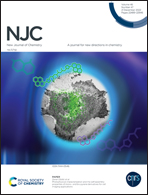Unexpected ring closures leading to 2-N,N-dialkylaminoareno[1,3]tellurazoles†
Abstract
A novel synthetic method has been developed to prepare 2-N,N-areno[1,3]tellurazoles following a one step procedure from readily accessible precursors. Products were obtained in yields up to 78% by reacting bis(2-aminoaryl)ditellurides with dialkylformamides in the presence of phosphorous trichloride or phosphorous oxychloride. An analogous approach furnished 2-(N,N-dimethylamino)naphtho[1,2-d][1,3]tellurazole from 3-chloronaphtho[2,1-c]-1,2,5-oxatellurazole. This method was found to be specific to the synthesis of 2-dialkylaminotellurazoles and does not proceed with sulfur or selenium congeners. A characterization of two selected samples by X-ray crystallography found a supramolecular wire motif resulting from intermolecular Te⋯N interactions for one of them.
![Graphical abstract: Unexpected ring closures leading to 2-N,N-dialkylaminoareno[1,3]tellurazoles](/en/Image/Get?imageInfo.ImageType=GA&imageInfo.ImageIdentifier.ManuscriptID=D2NJ03234A&imageInfo.ImageIdentifier.Year=2022)
- This article is part of the themed collection: 50th anniversary of ICCST: celebrating ICCST at its 15th Edition


 Please wait while we load your content...
Please wait while we load your content...